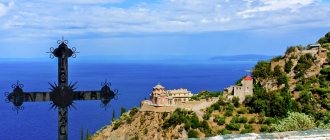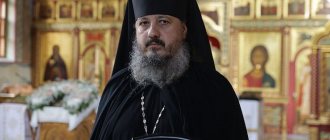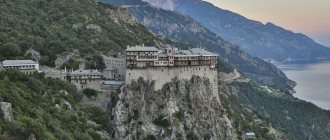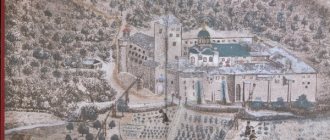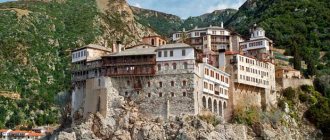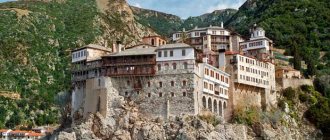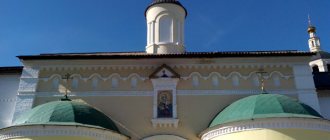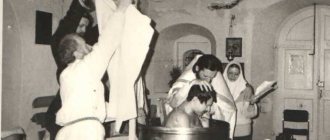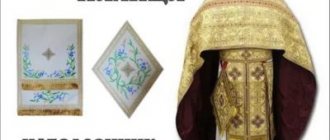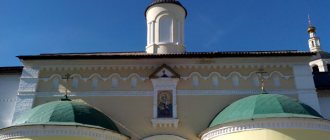Let's talk today about how monks live.
Let's imagine for a second that we have no money, no home, no friends and... we live in a cave or in the desert (as you like)... Can you imagine? Scary, even? And this is exactly how real monks live... We fuss, spin like a squirrel in a wheel, looking for... what? Did you notice? We are always missing something! We are always dissatisfied with something! We are always looking for the notorious meaning of life... But a real monk has already found it! The meaning of a monk’s life is in prayers for the whole world, for you, for me, for peace in the whole world. He is not looking for the meaning of life, because his life is already filled with meaning - to LOVE EVERYONE. Remember, “God is love!”
Monks are people who completely devote themselves to serving God
A monk is a person who has completely devoted himself to religious life, for which he has settled in a community of like-minded people. There are such people in different religions and cultures: Christians, Buddhists, Hindus, Taoists, etc.
A monk is a member of a religious community who has vowed to lead an ascetic life in accordance with church rules
In some places, monasticism was formed as a separate caste of people, in others it was inextricably linked with the priesthood, but in general, the general features of this phenomenon can be identified:
- Existence as a community;
- Regimentation;
- Religious orientation of activity;
- Severe restrictions;
- The laity has a special, respectful attitude towards monks.
Christian monasticism originates in the Essene tradition
Christianity arose on the foundation of Judaism, and Christian monasticism owes its form to the Essenes. This is one of the three lines of Judaism in New Testament times.
We know little about the Essenes, but there is reason to believe that John the Baptist studied in their community. It is possible that Jesus Christ himself learned a lot from them.
Monks, Saints Anthony and Theodosius of Kiev-Pechersk, in the painting by Saida Afonina
The reverent and scientific attitude towards religious literature, initiation rites, the harsh, regulated way of life of the Essenes - all this was reflected in the first Christian sects and has been preserved to this day.
Who becomes a monk: the best of people or those who have nowhere to go? Differently
We are, of course, primarily interested in the Orthodox monk. What do we know about him? The most important thing is the person who went to live in a monastery. This formulation is not entirely correct.
There are at least two types of people who entered a monastery.
Type 1. Fugitive hermits . These are those who do not want to live in human society. There are many reasons:
- Difficulty communicating with people . Often due to the fact that there are psychological problems and complexes. The stereotype drives people to a monastery to bury themselves from the world, but this will not work. A monastery is the same society, only small. And it is far from a fact that in this society you will be able to find people of your own circle. On the contrary, very complex, contradictory people often live in the monastery and are not easy to get along with.
And you won’t be able to sit alone somewhere in a cell, reading a prayer. The monastery's charter requires working, praying, and eating food together.
- Laziness. It happens that a person has not found a job to his liking, and in general he is tired of spinning around in eternal lack of money, being horrified by the political situation, paying rent, providing himself with a piece of bread. There's not much to lose. Why not go to a monastery where they provide food and housing? Just think, you need to communicate with God. It's even useful.
This approach will lead to disappointment. There is a lot of work in the monastery. Often even more than in the world. You won’t be able to soak in bed until noon: get up at dawn, or even earlier. There is a lot to do, and the conditions are not great. So soon the lazy man will howl in despair and return home.
Monk
a person who has devoted himself to religious life and settled in a community of like-minded people
- Rejected by society . Among this category, there are more often people with external deformities, a damaged reputation, or criminals who have served their sentences. Everyone turns away from them. It’s difficult for a freak to interact with others; not every job will hire an ex-prisoner.
It’s good when you can show willpower and achieve your goal, but only a few succeed. And everyone is accepted into the monastery, so why not? There is, of course, no sincere desire to remain in the monastery until the end of life. Such an initiative does not bring anything good.
- Old men . In such cases, the monastery is presented as a kind of nursing home, where every elderly person is accepted. It is easier for him to live out his life surrounded by spiritual society. But the elderly cannot fulfill the demands placed on them and become a burden. There is nothing of a monk in them, and the decision is dictated by the fear of loneliness.
- Disappointed in life . These are emotional people who encountered trouble and decided to hide behind the walls of the monastery from all future troubles. They won't last long because they are weak-willed. Such people quickly escape from the monastery and until the end of their days they talk about the “horrors” they experienced there.
- Fanatics . There is a category of fanatical believers. They do not feel the spirit of Christianity, but cling to external attributes. The image of a monk dressed in a black robe evokes awe in them. But behind the craving for the external, there is no content.
In the photo - Orthodox monks
Type 2. Those who sincerely strive for God . Their action is dictated by deep love for God, sincere faith, and the desire to devote themselves to serving the Higher Powers. These are people who go to a monastery not because they are fleeing the material world, but because isolation helps them cultivate better qualities.
And these qualities are needed not only for oneself, not for one’s salvation, but because the person himself will be able to bring more good into this world, performing various services and reflecting on the eternal. These monks:
- do work around the monastery;
- accept believers;
- write theological works.
And they do a lot of other things. Some people create church utensils, while others can heal people. Everything depends on your abilities.
Women's Orthodox hermitages
Women were allowed into the monastery only as part of a religious procession on holidays. Among the Christian believers there were enough willing to devote themselves to the service of the Lord.
Seraphim-Znamensky Skete
In the south of the Moscow region, in Domodedovo, there is a convent. It is famous in the world for the fact that in it anyone can meet true Faith, receive Hope and know Love. Its inhabitants went through difficult times, but everything is behind them, the nuns’ lives are getting better.
Pokrovsky Skete
In a deep forest near St. Petersburg there is a beautiful temple. It houses sisters who combine serving God with helping people suffering from drug addiction.
The lifestyle of an Orthodox monk should be like that of an angel
How do righteous monks, those whom we could call exemplary, live? It might sound strange, but - like angels.
Here we need to clarify. An angel in Christianity is a projection of divine power or a certain being of a higher nature in relation to man. The angel is incorporeal, but his life is still quite difficult due to the fact that he is obliged to take care of his perfect nature and always correspond to it.
Man is not perfect, but a monk must strive for perfection.
Christianity does not believe that modern man is as perfect as an angel. Even a monk. But you can strive for this. A layman takes this path, stumbles, repents and tries again. But a monk lives differently: he is one who has given lunch to the Lord and to himself to live righteously.
And this is not just a promise, but an unshakable decision. If all the monasteries disappeared, this man would still have to maintain the same pious lifestyle:
- Early rises;
- Work (obedience) for the benefit of the brothers, believers and the monastery itself;
- Long prayers;
- Restrictions in various areas;
- Submission to the highest clergy of the monastery;
- Don't eat meat.
And many other aspects of Christian monasticism.
Orthodox monasteries in Russia
The number of monasteries began to grow sharply after the adoption of church reform by Tsar Alexei Mikhailovich and Patriarch Nikon. Part of the clergy did not accept it, and opponents of the new rules were persecuted by the authorities and the church. As a result, in order to avoid punishment, they went into the deep forests and founded monasteries, settling away from cities and villages.
Chelyabinsk region, Old Believer monastery
The Old Believers called any building where believers lived a monastery. These were huts, similar to hunting lodges, and large settlements with permanent buildings.
They differed from ordinary secular villages in their isolation and running their own household. In remote places, cells and temples located at a great distance from each other were connected to each other by camouflaged underground passages. In case of danger, the monks disappeared, moving to their brothers.
Monasticism is not just going to a monastery, but a way of life with restrictions and vows
It’s not enough to go to a monastery. This is only the first step with which monasticism begins. Much more important are the restrictions that a person voluntarily accepts. These are the vows:
Vow of virginity (chastity). The idea here is to snatch a person from the various blessings of the world, its temptations and pleasant sides. They are believed to distract from the spiritual. And the intimate sphere has the strongest lever of influence on a person.
But making a vow is one thing, but keeping it throughout your life is another. It is difficult to find similar statistics about Orthodox monks, but medieval Catholic monks were often caught breaking the vow of chastity, but went unpunished.
If something like this were to come to light today, the monk could face expulsion from the monastery. In order to prevent such cases from occurring, strict prohibitions have been introduced on the presence of women in the men's monastery.
Vow of obedience . Obedience is a situation where a student obeys the senior monk to whom he is assigned. A person may well have several obediences at once. This is a standard situation. At the same time, obedience must be with reasoning. No one should listen to an elder if he incites him to commit criminal or immoral acts. This applies to any area.
An Orthodox monastery is a religious community of monks or nuns that has a single charter, as well as a single complex of liturgical, residential, and utility buildings belonging to it
Even monks are capable of making mistakes. If the demands of an elder differ, for example, from the instructions of the holy fathers, attention should be drawn to this and senior management should be notified. The question of the mentor's competence needs to be raised.
But in general, controversial situations are rare, and therefore ideologically obedience is understood as absolute.
Vow of non-covetousness . This is the abandonment of personal property. Even a monastery icon painter does not use his own tools, but those that are owned by the monastery. You cannot go to a monastery, become a monk and still own a three-story country house. Monasticism is a serious step. It is not made in such a way that there is somewhere to return.
This requirement often led to problems. For example, there is a well-known case of the involuntary nun Margarita Delamar, who was not allowed to receive her due inheritance and return to the world because she gave a meal of non-covetousness. Although it is known that the real reason was not this, but the intrigues woven against her.
"three types of monastic situation."
First situation
- This is an already established old monastery. This is what is usually meant by the words “becoming a monk.” Becoming a monk means for many people entering a monastery. And Father Seraphim writes that spiritual fruit in such a monastery is achieved through the suffering associated with staying in such a place, as well as through continuous connection with the past. Such a monastery, as it were, pulls a thread from the past, people join it, and as a result of this they get spiritual fruit, plus the suffering associated with staying in such a monastery.
Here Father Seraphim speaks about monasteries in the tradition of the Church Abroad. In August of this year, just a month ago, Abbess Alexandra from ROCOR(A) gave a report on the monasteries of the Church Abroad. She visited all the historical monasteries of the ROCOR. She describes four convents of the Church Abroad and the main monastery of the ROCOR, Jordanville. Her report carefully examines the routine of life and worship in such monasteries, but nowhere in the entire report is it mentioned, even briefly, the main activity of a monk - the Jesus Prayer. Maybe she has her own opinion, of course, but I also heard from other eyewitnesses who visited these monasteries that the main efforts there are aimed at receiving pilgrims and maintaining ancient buildings. Usually these monasteries have quite large real estate, which is difficult to maintain; the monks work for this, and I have never heard of the Jesus Prayer in the monasteries of the Church Abroad.
Although there is a slightly different monastery, different in spirit, it is located in Boston. In the USA there are even several such monasteries in the Church that is friendly to us, where they have a completely different attitude towards the Jesus Prayer, but they are all English-speaking, in a slightly different, Greek, tradition, but such monasteries do exist.
The second type of "monastic situation"
about which Father Seraphim writes, arises when a person begins to strive himself, according to his understanding of the examples of the great ascetics of the past. Father Seraphim explains that this is the most dangerous of all the monastic paths open today. And it's clear why. Father Seraphim gives many reasons why this is dangerous, and explains what qualities a person must have - an almost impossible combination of qualities - in order to survive like this. And, besides, such a hermitage in Russia is also a physically dangerous path. If in America, where Father Seraphim lived, you can fence off the territory, write “private territory”, and it will be quite well guarded, then in Russia all this is much more dangerous.
But there is one more thing that did not exist in the time of Father Seraphim, which is both good and evil. These are modern means of communication. If such an ascetic really tries not to use the Internet, then he chooses the second type described by Father Seraphim with all its dangers. If he uses the Internet, then he approaches the third type, because he has some like-minded people with whom he can communicate, and then he gets what Father Seraphim called the third type of “monastic situation.”
The third type of “monastic situation”
occurs when a group of several people begins to struggle, supporting each other. This case is very common for true Orthodoxy in Russia. There are parishes here, they are either apartment-type or churches (but the TOC managed to retain quite a few churches), in these communities there are people trying to live monastically, they usually stick together, and later one of them receives tonsure. Thus, at the parish, a small monastic community is obtained, usually of an urban type, which is often called monasticism in the world.
There are many problems here, but four lie on the surface. The first is how to keep in shape, the second is how to maintain some isolation from the world, the third problem of female monasticism is how to deal with lust (this is the other side of the problem of obedience), and the fourth problem is collective pride.
The formation of an Orthodox monk takes place in 2-3 stages: novitiate, monasticism, great schema
Monasticism is divided into three stages:
Stage 1. Novitiate . A person at this stage still does not owe anything to the monastery. He himself is just looking closely, and the monks are looking closely at him. The future monk is given instructions that he must carry out. This is a kind of test to avoid mistakes. After all, there will be no turning back. The essence of novitiate is the performance of various works in the monastery. Usually it lasts a couple of years, but it can last longer or shorter, depending on the situation.
2 years
This is approximately how long obedience before monasticism lasts
There are also workers. This is a slightly different phenomenon. A worker works at a monastery, but does not have the goal of becoming a monk.
There are cassock novices - these are those who have some monastic privileges (for example, wearing a cassock)
Stage 2. Monasticism or tonsure into the mantle. For many, this is the end of the monastic path. The person has already been accepted into the monastery on equal rights with others. He begins to lead an ordinary monastic life. The monk is given a new name, the old one seems to have died for the material world.
Stage 3. The Great Schema is the same likeness to an angel. A schema monk is a monk who lives under the strictest restrictions, constant prayer, and hermitage. It is as if he already has one foot in the spiritual world and is far from only the laity, but also from the monks. They give him a new name again.
What is a monastery
The meaning of the word skete appeared after the 5th century, when Christians persecuted by pagan authorities retired to the Skete desert.
People who renounced earthly goods and completely devoted themselves to serving God often went to remote places and lived there. What are monasteries today? These are settlements of monks leading an ascetic lifestyle. They are subordinate to monasteries; they themselves do not have such status or are located far from churches, in solitude.
Usually 1-5 people live in a monastery. Everyone has their own cell, common property and joint farming. Even if they are located next to the monastery, they have their own separate temple, often a small chapel. Their life is subject to their own rules, more rigid and strict than in the monastery.
Abode of monks - monastery
A monastery is the name of a place where monastic communities live. In Orthodoxy there is a certain general idea of what it should include:
- Cells;
- Temple;
- Refectory;
- Belfry.
Kiev-Pechersk Lavra - one of the first monasteries in Rus'
Etc. But usually they proceed from the needs of a particular community, conditions and opportunities. It happens that the monastery simply acts as a building taken (purchased, accepted as a gift, rented) from the city government, and it happens that the monks rebuild vast territories with a bunch of buildings for different needs.
“Athos is a place where a living monastic tradition is preserved”
Holy Mount Athos is known all over the world and has enormous authority in Orthodox circles. Athos is often perceived as perhaps the only place on earth that preserves the true purity of Orthodoxy and ancient monastic traditions. Is it so? Is the Holy Mountain the center of universal Orthodoxy? Can we call it a “tuning fork” by which you need to compare your views and beliefs? How do Athonites view the church situation in Ukraine? The editors of the magazine for the clergy “Pastor and Flock” talk about this and much more with the church historian and researcher of Athos, director of the International Institute of Athos Heritage (MIAN), editor-in-chief of the almanac “Athos Heritage”, head of the Pilgrimage Service “Athos” Sergei Viktorovich Shumilo .
– Sergey Viktorovich, sometimes you can hear the opinion that Athos is the center of universal Orthodoxy... How fair is it to think so?
– Athos has never been the center of universal Orthodoxy. It is not and has never been some kind of church-administrative religious center, like the Vatican. Therefore, comparisons between Athos and the Vatican are fundamentally incorrect. It would be more correct to say that Athos is a kind of spiritual center, the focus of Orthodox monasticism and monastic tradition. This is truly a unique international center of Eastern monasticism in the history of Christianity, regardless of nationality and state affiliation.
During its heyday, there were about 300 monasteries on Mount Athos. Today there are only 20 of them and just over a dozen monasteries, as well as many cells and kalivas. As part of the Greek state, Athos enjoys the rights of an autonomous monastic republic, which is enshrined in the Greek Constitution. But the main thing is still not this, but the fact that here, throughout the millennium, the monastic tradition of continuity from elders to disciples has been inextricably preserved. And the main task of the “citizens” of this “republic” is prayer. And in this regard, Athos is indeed a kind of spiritual center of monasticism and prayer, but not an administrative one.
In addition, it is important to remember that it was Mount Athos that the Mother of God herself chose as her Destiny. Therefore, Athos throughout the Christian world has been revered since ancient times as the Destiny of the Mother of God. And this is not some kind of artistic metaphor. This is the true spiritual Destiny of the Mother of God. And if a pilgrim on Athos is in the right spiritual mood, then he feels the presence of the Mother of God there everywhere and incessantly, no matter where he is - be it in monasteries or monasteries, even in hermit cells, in the mountains or forests...
With the right spiritual attitude, the presence of the Mother of God is felt here as in no other place on earth. But it is very important to be internally prepared for this.
Monastery of Simonopetra on Mount Athos. Photo by Sergei Shumilo
– You do a lot of studying the role and significance of the Athonite heritage in the history and culture of Ukraine. Can you tell us why exactly it was important for Ukraine?
– For many centuries, the Athonite monastic heritage played an extremely important role in the development of domestic spirituality and culture, both in the era of Kievan Rus and in later times. Particularly important was the formation, under the influence of Mount Athos, of the Kiev-Pechersk Monastery, which was a kind of “nursery” and center of monasticism, spirituality, book learning, culture and enlightenment throughout Rus'. In fact, the culture of Kievan Rus was largely formed under the influence of monasteries, which were strongly influenced by the Athos heritage.
On Athos, the first ancient Russian monastery was the monastery in honor of the Dormition of the Virgin Mary “Xylurgu” (Drevodel). It was founded with the patronage of the Kyiv princes St. Vladimir the Baptist and St. Yaroslav the Wise. Here, according to the surviving monastic tradition, the initial spiritual formation of St. took place. Anthony of Pechersk, who later founded the Kiev-Pechersk Monastery.
Old Russian monastery of Xylurgu on Holy Mount Athos. Photo by Sergei Shumilo
– And besides the Old Russian period, did Athonite monasticism have influence in the lands of Ukraine?
- Undoubtedly. Thus, during the heyday of Palamism in the 14th-15th centuries, it was under the influence of the Athonite heritage that the period of “hesychast revival” began in Rus', which deeply affected the formation of our original and deeply spiritual culture. The most outstanding Afonite, who made a significant contribution to the development of spirituality and culture of Ukraine, was the Kiev Metropolitan St. Cyprian (Tsamblak). During his metropolitanship, many books were brought to Rus' from Athos, translations were made, and the tradition of hesychasm became widespread.
Athos and its devotees played an important role in the spiritual and cultural revival in Ukraine in the 17th century. Under their influence, new polemical works are written, schools are opened (Ostrozhskaya and Kiev-Bratskaya), books are published, the Zaporozhye Cossacks are being churched and involved in the struggle for religious and national liberation.
The most prominent of the Ukrainian Athonites of that time was the Venerable Elder John of Vyshensky the Holy Mountain, as well as his associates St. Job Knyaginitsky, blessed Cyprian, Isaac Boriskovich, St. Job (Zhelezo) Pochaevsky, Afanasy Mezhigorsky, Joasaph Gustynsky, Isaiah Kopinsky, Joseph Koriatovich-Kurtsevich and others. Close spiritual and cultural ties with Athos at this time were maintained by the Kiev-Pechersk, Kiev-Bratsk, Mezhigorsky, Trakhtemirovsky, Samara, Manyavsky, Pochaevsky, Gustynsky, Mgarsky, Svyatogorsky, Motroninsky and many other monasteries.
“Little Russian” Ilyinsky monastery on Mount Athos
The Ukrainian Cossacks also maintained close ties with Athos, invited experienced mentors and elders from there, made generous donations to the monasteries of Athos, carried out pilgrimages, and often many Cossacks themselves took monastic tonsure on Athos and labored in the monasteries of Athos. In 1747, they founded a separate Cossack monastery on Mount Athos called “Black Vyr”. We were able to find information about it for the first time several years ago in the archives, after which we were able to piece by piece reconstruct the history of this Cossack Athonite monastery.
Cossack monastery "Black Vyr" on Mount Athos. Photo by Sergei Shumilo
Sergei Shumilo in the ossuary of the Cossack monastery “Black Vyr” on Athos]
Another native of the family of Ukrainian Cossack priests, St. Paisiy Velichkovsky founded the famous St. Elias monastery on Athos, which in many documents was often called “Little Russian”. There, too, mainly former Zaporozhye and Transdanubian Cossacks labored. Several years ago we published for the first time the correspondence of St. Paisiy Velichkovsky with the last Kosh chieftain of the Zaporozhye Sich, and now a canonized saint, is right. Peter Kalnyshevsky. So, Ukraine’s ties with Mount Athos throughout its centuries-old history have been very close.
– Recently the media reported that on Mount Athos you managed to discover an ancient manuscript from the 17th – 18th centuries with records of Ukrainian hetmans and Cossack elders who donated to the monasteries of Mount Athos. Can you tell us about this?
– Yes, this manuscript is a unique monument that reveals hitherto unknown pages of close ties between the Ukrainian hetmans and Cossack elders with Mount Athos. In particular, the noble Cossack families of Ivan Samoilovich, Ivan Mazepa, Danila Apostol, Ivan Skoropadsky, Leonty and Pavel Polubotok, Vasily Borkovsky, Yakov Lizogub, Semyon Paliy, Ivan Obidovsky, Vasily Kochubey, Ivan Iskra, Mikhail Gamaliya, Ivan Gulak, Ignatius are recorded here Galagan and many others.
Among the church figures, attention is drawn to the listed families of Archbishop Theodosius of Chernigov, Metropolitan Stefan Yavorsky, other bishops, as well as the abbots of the Kiev-Pechersk, St. Michael's Golden-Domed, Pustynno-Nikolsky, Mezhygorsky, Vydubetsky, Chernigov-Yeletsky, Mgarsky, Gustynsky and other Ukrainian Orthodox monasteries.
Sergei Shumilo holds the Athos memorial in his hands
– Are you planning to publish this manuscript?
– Yes, our institute is now preparing this Athos commemoration for publication as a separate book, so that this valuable source is available to domestic researchers. In addition to the re-publication of the memorial itself, for each family of Cossack elders mentioned there, comments will be submitted describing the biography of the donor and his family. We are currently working on these comments. After all, this manuscript can serve as a valuable source in future research on the history of the Church, Cossack elders and Ukraine during the Hetmanate.
– Returning to modern times... How fair is the opinion that Mount Athos is now a kind of “tuning fork” against which one must compare one’s views and beliefs?
– It depends on what views and beliefs we are talking about. If we are looking on Mount Athos for confirmation of some earthly events or processes, political ideas and ideologies, then it is in vain. As I have already said, Athos is a place where a living monastic tradition has been inextricably preserved for a thousand years. This is what makes him valuable.
One of the important components of this tradition is hesychasm (sacred silence), the experience of unceasing inner doing of the Jesus Prayer. It is very important for those who strive for a genuine spiritual life to join such a living and intact spiritual tradition of Eastern monasticism. After all, in our country this tradition was repeatedly interrupted, especially in the 20th century during the years of atheistic persecution. Therefore, this Athos-hesychast thousand-year experience is truly a “tuning fork” by which one should compare one’s spiritual life. But this does not apply at all to socio-political events.
Panteleimon Monastery on Mount Athos
– You can often hear a stereotype that Athos monks and elders have almost supernatural qualities... Others, on the contrary, say that Athos is no longer the same, that it has “fallen”, and that there are no more genuine ascetics and elders...
– This is what speaks in people about their “magical consciousness”, the need to endow other people with some supernatural, almost “magical” qualities. And when they are disappointed in such unjustified expectations of their own, they begin to judge. Unfortunately, this is typical for our people. But there is no need to overestimate the Svyatogorsk monks, like any others. After all, several thousand monks from different countries and different nationalities live on Mount Athos. And they are not some kind of “celestials” who descended from somewhere from “heaven” to earth. These are the same living people who came from the same world... Many of them may have different opinions on certain earthly issues, different political views and sympathies. Various disputes and disagreements also arise between them. As a rule, they went to Athos to get away from the influence of the world and worldly vanity, in order to wage an internal battle with their own sinfulness and improve. However, not everyone succeeds. This is life... Some, as a result of constant internal struggle, reach the heights of holiness, others, on the contrary, fall.
Entrance to the Athonite cave cell on Karuli. Photo by Sergei Shumilo So there are also living people there who have their own shortcomings, passions and sins. It has always been this way. This is real life. By the way, since representatives of various nationalities live on Mount Athos, sometimes disagreements and even feuds on national grounds occurred among the Athonite monks. This became especially acute in the 19th – 20th centuries.
So no “supernaturalism”. By the way, you shouldn’t think of the Athonite monks as some kind of “soothsayers” or “fortune tellers” who see the future, predict wars, etc. Even the most experienced Athonite elders do not do this. After all, they have completely different tasks - to help a person improve spiritually and morally. As has already been said, eldership does not have any “magical” qualities. This is, first of all, clergy, shepherding. Moreover, if the shepherd begins to take a lot of interest in politics, giving out some kind of political forecasts and “prophecies,” then genuine elders always warn them to stay away from them, since there may be delusion here. A spiritually experienced mentor looks first of all at the spiritual reasons for this or that phenomenon and avoids politics.
So in the more than thousand-year history of asceticism on Mount Athos, there are known examples of both unprecedented holiness and the falls of individual monks.
– How can one understand whether he is a genuine ascetic or not?
– First of all, you shouldn’t “chase after the elders.” You need to look not for the elders, but for your own inner unity with God, internal purification and rebirth, in which the elders or confessors are just a means to achieve it. Guides who can help you spiritually, tell you if you hear. Unfortunately, in post-Soviet times, we have overly idealized and even exaggerated ideas about both the elders and Mount Athos.
Hegumen of the Athos Panteleimon Monastery Schema-Archimandrite Jeremiah (Alekhine) As I already said, in our own imagination many of us began to endow the elders with some kind of “magical” qualities, which is far from the case. Well, by the way, the ascetic, immersed in unceasing prayer, is always laconic. This is also one of the distinctive qualities. Maybe he sees something, but he never shows it. Moreover, he does not engage in political propaganda or fortune-telling, and does not scatter words and predictions left and right. After all, the literal translation of the word “hesychia” is silence.
There are many holy ascetics on Mount Athos even now who perform their feats in secret, without showing it to outsiders. And only God knows that this is a great saint. And to everyone around him, even to his brothers, he may seem like some completely simple, ordinary monk who carries out ordinary obediences somewhere in the kitchen or garden, and is unremarkable from the outside, as was the case with St. Silouan of Athos. After all, hesychasm is an internal activity, an unceasing internal Jesus prayer performed in the recesses of the soul. This is an internal, not external, desire to connect your mind and lips with your heart, and through your heart - with God himself, and learn to live in such an internal state continuously. But this is the most difficult thing. And, alas, many who come to Athos these days are not looking for this at all...
– You talked about cases of falls among Athonite monks. Were there any cases of falling away from Orthodoxy on Mount Athos into heresy or schisms?
Of course, as in any living organism consisting of real living people, there have been cases of falling away from Orthodoxy. As in any Church, this has happened throughout history.
Monk Nil (Reshetnikov) on Stary Rusik. Photo by Sergei Shumilo
– Can you give examples?
– There were periods when some monasteries on Mount Athos even accepted the union. So in 1274 the Union of Lyons was adopted. By order of the Pope and Byzantine Emperor Michael VIII Palaiologos, a detachment of soldiers was sent to Athos, who by force tried to force the Holy Mountain residents to accept the union. Some monasteries on Mount Athos then accepted it. The Great Lavra was one of the first to go over to the side of the Uniates. However, the majority of Svyatogorsk monasteries and Protats remained in opposition. Severe repressions fell on those who disagreed: Zograf, Iveron, Vatopedi and other monasteries suffered, many of their inhabitants were executed or expelled from Athos. Later, in 1308, the Holy Mountain suffered a new test - the invasion of the Catalan knights. Then they killed many monks on Mount Athos and completely destroyed several monasteries, incl. and our ancient Russian monastery of St. Panteleimon, now known as “Old” or “Mountain” Rusik.
The ruins of the Athonite ancient Russian monastery of St. Panteleimon "Nagorny Rusik"
One can also recall the famous disputes about hesychasm between the Athonite monks of St. Gregory Palamas and Barlaam of Calambria in the 14th century. The latter, as is known, at one time lived on Mount Athos and opposed the hesychast teachings; later he fell into Catholicism and became a Catholic bishop there.
Sergei Shumilo at the excavation of the remains of Athonite monks near the walls of Protat, killed by Catalan pirates. Photo 2015
From more recent events, for example, one can recall the persecution of the elders-kollivads in the horse. XVIII – beginning XIX centuries Some Athonite monasteries then acted as cruel persecutors of this Athonite hesychast movement. In 1774, an anti-Kollivad council was held at the Kutlumush monastery, at which many famous Athonite hesychast elders were condemned as “heretics.” Among those condemned and expelled from Athos were the now revered Orthodox saints Athanasius Parios, Macarius Notaras, Neophytos Kavsokalivit and other Kollyvad elders.
At the beginning of the twentieth century, the so-called outbreak broke out on Mount Athos. “name-worshipping turmoil,” which led to very strong unrest and clashes among the monks.
So, although Athos is a holy place, it is not immune from temptations and falls among monks, who are just as living people. But this has never diminished the significance of Athos as a holy place and the Lot of the Mother of God. It is important, first of all, to set the right priorities within ourselves, then the external failures of individual monks or even monasteries will not confuse us.
– Is it true that Athos recognized the newly created “OCU” in Ukraine, which united former representatives of the schismatic groups of the UOC-KP and UAOC?
– The Holy Kinot of Athos is not authorized to resolve issues of recognition or non-recognition of certain churches or church groups; this is not its competence, because Athos is not a separate Local Church. Therefore, the Holy Kinot did not make any decision on this issue. At the moment, different monasteries have different opinions on this issue, and each monastery independently decides for itself. Therefore, there are monasteries that accepted the OCU delegation, and there are monasteries that refused to accept.
To avoid a split between the Athonite monasteries, the Holy Kinot deliberately does not want to take one side, maintaining neutrality and awaiting a resolution of this issue at the pan-Orthodox level. This is the position. At the same time, Kinot officially refused to send a delegation to Kyiv on behalf of Athos for the enthronement of the new head of the OCU. The abbots of Xenophon and Vatopedi, who came to Kyiv, represented only their monasteries and came as representatives of the delegation of the Ecumenical Patriarchate, and not as representatives of St. Kinot Athos.
Many people in existing disputes want to see Mount Athos on their side, and therefore often resort to conscious or unconscious distortion of facts. However, as always, the main task of the Athonite monks is not participation in church-political processes, but unceasing prayer and hesychia (sacred silence). Therefore, it is unlikely to expect any sensational statements or decisions in the near future. It is likely that for now, different positions among various monasteries will remain in the future... But, despite different understandings of the problem, they all continue to pray for an end to the schism and hostility between the Orthodox believers of Ukraine. It is important.
– Which of the modern Athonite ascetics would you note first?
– Probably Elder Jeremiah (Alekhine). In any case, it is the closest to me personally. He reposed on August 4, 2016 at the 101st year of his life. This is a man whose life spans entire eras. Having seen the light in 1915, it survived revolutions, wars, and repressions, and went through both Soviet and Nazi concentration camps. His worldly life was closely connected with Ukraine. His entire family was dispossessed and exiled to Siberia; after escaping from the camp, he hid for many years, working in the Donbass, at a metallurgical plant and a bakery. During the war, he was forcibly taken to do hard work in Germany. At the height of Khrushchev’s persecution of the faith, he became a monk, labored in the Holy Dormition Monastery in Odessa and studied at the Odessa Seminary, and eventually left for Holy Mount Athos. For more than 35 years he was the abbot of the St. Panteleimon Monastery on Mount Athos. He always remembered Ukraine, said that he prayed for it, for peace, worrying about the events taking place here.
Hegumen of the Athos Panteleimon Monastery Schema-Archimandrite Jeremiah (Alekhine) He often liked to repeat that one must live with God in the heart and do nothing without Him. “If you do everything according to God’s commandments, out of love, then peace will enter your heart, and everything will be fine,” said the elder.
Having experienced a lot of grief, suffering and hardships during his long life, he not only did not become bitter, did not lose faith, but even from these difficult trials he remembered only the best, the kindest... Even when remembering the terrible events in his life, he always spoke with a smile, like something pleasant. And most importantly, I thanked God for everything. And he taught everyone not only by word, but above all by personal example - to love and not remember evil. This example of love and forgiveness is very necessary for all of us today.
– What would you like to wish the readers in the end?
– Unfortunately, we are characterized by biased political or ideological views, predilections that often split entire families and society, but at the same time about the most important thing - about the gospel example, about the covenant of St. Seraphim of Sarov “Acquire a peaceful Spirit in your heart!” - we forget. Many Athonite elders constantly remind us of this very thing. And Elder Jeremiah (Alekhine) often said that, first of all, you need to acquire a peaceful Spirit within yourself, then there will be peace around you. It is important for everyone, regardless of political views or religious affiliation, to learn this.
And when all kinds of political passions, disagreements and confrontations boil inside us, regardless of the colors of the flags and ideologies, we move away from God, and therefore from the world. Father Jeremiah was convinced that one can only approach God through love, because God is love. Without love, nothing good is possible; you must strive for it, acquire it within yourself. This is what the centuries-old Athonite heritage teaches us. This is, first of all, what makes it valuable to us. So, for example, Elder Silouan of Athos in his works teaches how to gain peace in your soul, how to learn to love your enemies. After all, it is not difficult to love loved ones, relatives, those who do us good, but it is very difficult to love those who wish us harm. But this is one of the most important commandments of Christ - to learn to love our enemies... Are we fulfilling it?
Perhaps that is why the Lord often allows such situations to test our faith, to trim it, like a sculpture, so that it corresponds to the Gospel commandments, which we talk a lot about, but do not always observe. Therefore, I would like to end with the wish to become at least a little closer to these gospel covenants. Peace to you.
Magazine for the clergy “Pastor and Flock”, No. 1, 2022, pp. 48-56.
Buddhist monks differ from Orthodox monks, although they also have no property and lead a spiritual life
When we think of monks, besides Christians, Buddhists are the first ones that come to mind. A sort of shaven-headed Easterners, dressed in bright dresses and demonstrating supernatural abilities.
This is partly true. But talking about Buddhism as a whole is wrong. It is a combination of different movements, and each has its own form of monasticism.
Buddhist monasticism is one of the earliest forms of organized religious monasticism that has survived to this day. In the photo - Buddhist monks
But some common features can be identified between Christian and Buddhist monks:
- Period of obedience;
- Striving for the spiritual;
- No property of your own;
- Strict restrictions.
But there are no less differences:
- Buddhists have stricter restrictions;
- Buddhists do not emphasize faith in God and often do not consider this issue;
- Buddhists do not have a strict hierarchy;
- Buddhists have no central government;
- Buddhists do not shy away from the world, but willingly communicate with the laity and receive gifts from them;
- Many Buddhist monks practice mystical practices and martial arts.
By leaving a comment, you accept the user agreement
